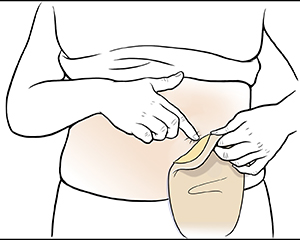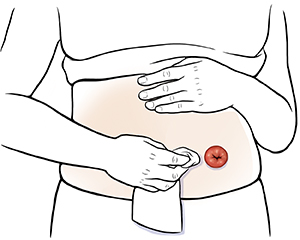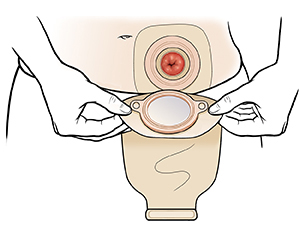Your Child's Ileostomy: Changing the Pouch
Soon after your child's surgery, stool will start to pass from the stoma. At first, a nurse will change the pouch. Before going home, you and your child will need to learn how to change the pouch. Key things to remember:
- You/your child will need to change your pouch every 2 to 3 days to prevent leakage and skin irritation.
- The pouch should be emptied whenever it is 1/3 full.
- When changing the pouch, you/your child must always wash your hands for at least 20 seconds before AND after caring for the ostomy pouch (hum “Happy Birthday” twice if you need a timer).
To change the pouch, follow the steps below.
Start by gathering what you/your child will need:
- Plastic bags
- Clean towel
- Paper Towels
- Extra skin protection, if desired
- Scissors (if needed)
- New pouch
Step 1. Remove the used pouch
- If your child uses a drainable pouch, empty it first.
- Open the Velcro closures or remove the clamp and set it aside (if applicable).
- Have your child sit on or next to the toilet.
- Start at the upper edge of the skin barrier. Carefully push the skin away from the barrier with one hand.
- Slowly peel back the skin barrier with the other hand.
- Peel all the way around the skin barrier until the pouch comes off. Seal the pouch in a plastic bag.
- Then put it in a second plastic bag. Throw it away in a trash bin.
 |
| Remove pouch |
Step 2. Clean around the stoma
- Wipe any stool off the skin around the stoma with a paper towel
- Gently wipe/clean the skin with warm tap water and wet paper towel. Wash right up to the edge of the stoma.
- Pat the skin dry with a clean towel.
- Do not use soap, treated body wipes or lotions when cleaning the skin around the stoma.
- After cleansing, apply no sting barrier film to protect the skin.
- Stoma powder can also be used for extra protection if needed for any skin irritation.
 |
| Clean around stoma |
Step 3. Put on the new pouch
- If your child does not use a pouch with a precut skin barrier, size and cut the opening to leave a 1/8-inch space around the stoma.
- Slowly peel the backing off the barrier and carefully place it over the stoma.
- If your child is using a 2-piece pouch, snap the pouch onto the barrier.
- Start at the bottom and work your fingers around the flange.
- Press the barrier against the skin. Hold and warm the barrier for 2-3 minutes with your hand over it.
- This will help to activate the adhesive and help mold the barrier to your child's skin.
- Secure the Velcro closures shut or clamp the tail of the pouch (if applicable).
 |
| Put on new pouch |
When to call your child's ostomy nurse or other healthcare provider
Call your child's healthcare provider right away if your child has any of the following:
- Skin around the stoma is red, weepy, bleeding, or broken
- Skin around the stoma itches, burns, stings, or has white spots
- Stoma swells, changes color, or bleeds without stopping
- Stoma changes size, becomes even with or sinks below the skin, or it sticks up more than normal
- Pus, foul-smelling drainage, or excessive bleeding from the stoma
- A stoma that separates from the skin or looks like it’s getting longer
- A stoma that is recessing (pulling back) into the belly
- Bulging skin around the stoma
- Blood in your child's stool
- Change in the color of the stoma
- Fever of 100.4°F (38°C) or higher, or chills, or as advised by your child's healthcare provider
- Nausea or vomiting
- Increased pain in the belly or around the stoma
- No gas or stool made after 24 hours
|